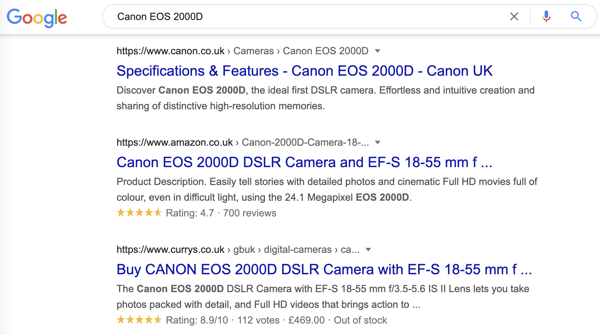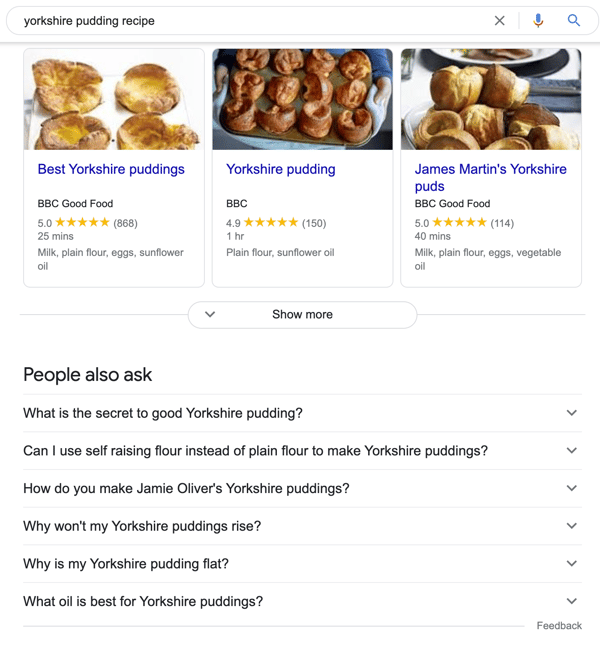No, Rich Snippets isn't the millionaire bad guy from a film about a youth centre being closed down, and replaced with a huge car park. There's no state-wide dance competition going on here, unfortunately.
Instead, we're going to run you through the basics of what rich snippets are, and how to utilise them in your SEO. And maybe make a rag-tag group of misfit friends along the way.
So, what are rich snippets?
Rich snippets, also known as rich results, are basically just Google search results with some added information within the listing. Snippets aren't shown for every Google result, but are commonly used in certain types of results, such as reviews, recipes, events and more.
Rich snippets are regular (organic) search results with additional information displayed underneath the page title, URL and meta-description. They are different from rich results, which are results showing additional features such as images, video or answer boxes.
This data is pulled from the structured data found in a page's HTML.
So, instead of seeing a search result like this:

You'll see this, with extra detail:

Rich snippets are, clearly, more visually appealing and eye-catching. Plus, rich snippets can show additional information that can encourage a potential customer to choose to click on your page instead of the alternative.
If your page has a higher star rating than your competitors, this'll be front and centre too. For example:

I was shocked to see Mary Berry's Yorkshire pudding recipe is lower rated than the BBC's. Feels like treason, but okay.
It's not just recipes - they can provide your product pages with a key advantage for search terms which show a clear intent to purchase.
For example, the added review information within these rich snippets make the Curry's and Amazon pages stand out more than the manufacturer's own, and can directly impact on sales.

Rich snippets only work with pages with certain types of information, and can even be limited by the type of device a user is on.
"How to" snippets can only be shown on mobile, for example. A few of the most popular rich snippets include:
- Reviews
- FAQs
- Software
- App Info
- Event info
- Ratings
- 'How to's.
- People, from celebs to profiles of professionals
- Businesses and organisations
- Video Content
- Music
Search engines can have a hard time understanding details like the number of review stars, or the price of a product. Using structured data, you can let Ask Jeeves or whoever all the rich and useful info you want seen, and pave the way for the search engine to show it in the search results.
Okay, now we've got the definition out the way, how can you use these little beauties to improve SEO?
How do rich snippets improve SEO?
Short answer: they don't. Long answer: they don't. Sort of. Rich snippets aren't used as a ranking factor by Google, but they can increase CTR, and do have possible secondary benefits.
Ranking high in search results is great, but people tend to click on stuff that is relevant to their needs, and the content of the snippet can increase the relevance of the result to the searcher.
So, rich snippets help make your webpages look more enticing. Mary Berry's Yorkshire pudding recipe is way more appealing, because it uses the reviews and other details to its full potential. Someone may pick hers over the BBC's if they're counting calories. Basically, it establishes trust, and acts as a little advert for your post.

For example, you can use these attributes as a competitive layer in the search engine results page. Snippets allow you to take up more space, with information that can catch the user's eye.
Even if you rank a little lower than competitors, the details in the snippet might just give you the edge.
But let's be clear, rich snippets don't improve SEO directly. Having structured data markup on a page alone won't make it appear higher in search results.
If you believe Google, that is. But it can affect behavioural data, which does have an impact on rankings. This might include:
- Click through rate
- Bounce Rate
- Time on site
- Relevance of results to user
So, the snippets will not only entice more people onto the page, but may also almost 'vet' the correct clients for you, meaning they are likely to spend more time on your page, which can have additional SEO benefits.
They might not be an official ranking signal, but rich snippets have the potential to really impact your SEO indirectly.
But we've been throwing this phrase around - "structured data". So:
What is structured data?
'Structured data' is, well, data that is structured.
Oh, you want more than that? Ugh, fine. Structured data is basically any data that is organised in a way which makes it easier for the search engines to understand. It lets you talk to search engines in a way they understand.
It's likely that structured data will become ever more important for SEO, as Google and other major platforms are using it more and more. If you looked at a Google search results page ten years ago, you were likely to see just ten links, and maybe a few ads on top.
Now, many searches will return lots of different result types, from images and video, to features like People Also Ask which shows key questions related to the search:

Many of these features are dependent on structured data, and the presentation of richer search results pages will become more widespread. For this reason it's important to use structured data, as it may become essential for your results to attract the attention of users.
Rich snippets are one way for search engines to display structured data they find encoded on a web page.
Without structured data, the search engine might have a hard time understanding how long the Yorkshire puddings will take to make, which images relate to the recipe, the list of ingredients, the steps etc. Without structured data, your result will not show this information.
When you add the recipe markup to your page you'll tell the search engine all this info e.g. The Yorkshire puddings take an hour, they'll need an ingredient you'll only find in a far corner of a Whole Foods.
Then, Google will show this info off as a rich snippet.
This all allows you to take a more proactive approach and have some control over how your search result is displayed.

How do you start using rich snippets?
Coding, unfortunately. Structured data is basically a type of coding which highlights specific types of data on your page.
When it comes to structured data, most websites use Schema.org.
This is because Schema is supported by all major search engines, and is pretty easy to set up. All you have to do is find the markup you want to use, for example 'recipe', and markup your content using the guidelines on that page eg. cookTime, recipeCategory, recipeCuisine, etc. etc.
If you use WordPress, there are plenty of plugins to choose from, including All-in-one Schema.org.
You can find plugins for most major ecommerce systems, but with a bespoke system, you're going to have to get your web developer on board.
Let's have a quick look behind the scenes, with Rich Benci, who went into detail for Search Engine Journal on the matter. He observed a pattern in how Google responds to the introduction of structured data markup:
- Google only starts analysing the new markup 10-14 days after it is introduced
- If everything is up to scratch, it'll start showing some rich snippets for some pages, but these will disappear after about 5 days.
- They'll reappear several days later, for the same set or another set. This might be repeated a couple of times.
- After 8 weeks, you should be rewarded with rich snippets throughout your site. This is if Google's analysis discovers no errors, by the way.
In summary
While rich snippets may not have a direct benefit on your search rankings, they are a valuable tool to make your results stand out, and provide key information to searchers that can persuade them to click through.For competitive searches, especially those with purchase intent, increased CTR through rich snippets can drive valuable traffic and revenue.
In addition, it's important to be aware of the value of using structured data for rich snippets and more. If your competitors are using structured data effectively and you aren’t, Google can understand their pages, and display them more prominently.

